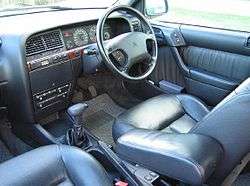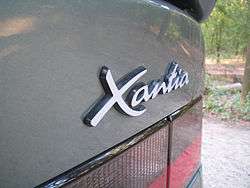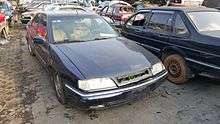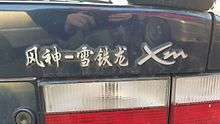Citroën Xantia
| Citroën Xantia | |
|---|---|
_01.jpg) | |
| Overview | |
| Manufacturer | Citroën |
| Production |
1993–2001 1993–2002 (France) |
| Assembly |
|
| Designer | Daniel Abramson (1989) |
| Body and chassis | |
| Class | large family car |
| Body style |
5-door hatchback (Berline) 5-door estate (Break) |
| Layout | FF layout |
| Related | Peugeot 406 |
| Powertrain | |
| Engine | |
| Dimensions | |
| Wheelbase | 2,740 mm (108 in) (Berline) |
| Length | 4,440 mm (175 in) (Berline) |
| Width | 1,755 mm (69.1 in) (Berline) |
| Height | 1,380 mm (54 in) (Berline) |
| Curb weight | 1,250 kg (2,760 lb)–1,430 kg (3,150 lb) (Activa CT) |
| Chronology | |
| Predecessor | Citroën BX |
| Successor | Citroën C5 |



The Citroën Xantia, pronounced "Zan-ti-a"[1] was a large family car produced by the French automaker Citroën, and designed by Daniel Abramson of Bertone. Presented to the press in December 1992, the car was produced between 1993 and 2001, with a facelift in 1998. Citroën sold over 1.2 million, Xantias during its nine years of production.
By January 2001, when production ended, Iran's SAIPA started production of the Xantia. Iran manufacturing ended by September 2010. However, production in France continued until October 2002, which overlapped with the C5 by eighteen months. The name "Xantia" is derived from Xanthos, meaning "yellow" or "golden" in the Greek language.
History
The Xantia replaced the earlier Citroën BX (which straddled both small and large family car segments), and maintained the high level of popularity of that model, but brought the car more into the mainstream to compete harder with its rivals, such as the Ford Mondeo, Nissan Primera, Rover 600, Toyota Carina E and Vauxhall Cavalier.
It signalled that Citroën had learned from the reception given to the staid Citroën ZX, introduced two years earlier, and criticised by contemporary journalists for its lack of traditional Citroën flair, in engineering and design. Citroën addressed these concerns in the Xantia.
The Xantia also used the traditional Citroën hydropneumatic suspension system pioneered by the older DS. It was initially only available as a hatchback (liftback) (Berline), but an estate (station wagon) (Break) version built by Heuliez appeared in 1995.
In-line with PSA Group policy, the Peugeot 406, launched two years later, used the same floorpan, core structure and engines as the Xantia. The Hydractive suspension system was not carried over, and the 406 utilised a more traditional spring suspension.
Sales in the United Kingdom were strong, and even though it was never able to match the volume of British favourites, such as the Ford Mondeo or Vauxhall Vectra, the car did help Citroën establish an strong foothold in the business car market in the United Kingdom.
Suspension
Hydractive
From an engineering perspective, the Xantia's biggest advance was the suspension. From launch, the more expensive models were available with an enhanced version of the XM's Hydractive, Hydractive II or H2, computer controlled version of the hydropneumatic self-leveling suspension. This used extra suspension spheres to allow a soft ride in normal conditions, but taut body control during hard braking, acceleration or cornering.
These models feature an innovation first seen on the ZX and then subsequently fitted to the facelifted XM - a programmed self-steer rear axle. On sweeping curves and tight bends alike, the rear wheels turn in line with the front wheels, sharpening responses and adding to driver pleasure.[2]
Activa active anti-roll bars
In 1994, the Activa technology was introduced, which is an extension to the Hydractive II suspension, where two additional spheres and two hydraulic cylinders are used together with computer control to eliminate body roll completely. This technology is more broadly known as active suspension, and the Xantia Activa has exceptional road holding comparable to true sports cars. It employs active anti-roll bars.
In the Swedish magazine Teknikens Värld's moose test the 1999 model of Xantia V6 Activa still holds the record speed through the manoeuvre - faster than the Porsche 996 GT2.[3]
United Kingdom models of the Activa came fitted with a XU10 2 litre turbocharged engine also fitted to the Citroën XM 2.0CT and Peugeot 605 SRi. It produced 150 bhp and 171 lb ft of torque and was a 'low-blow' type for smooth power delivery rather than outright bhp.
The Xantia was the last Citroën to use a common hydraulic circuit for suspension, brakes and steering like the pioneering Citroën DS. It was also the last Citroën car that used the green LHM hydraulic fluid. Later cars, such as the C5, used LDS instead.
Engines
Power came from the familiar PSA XU-series petrol engines, this time in 1.6, 1.8 and 2.0 displacements, a 2.0 16-valve version for the Xantia VSX, a turbocharged 2.0 engine, from 1995 onwards, a 1.8 16-valve and a 2.0 16-valve engine. In 1997, a 3.0 V6 engine was offered as top-of-the-line.
The popular XUD turbodiesel units in 1.9 (turbocharged: 92 hp (69 kW), low-pressure turbo: 75 hp (56 kW), or not: 71 hp) displacement proved to be the best-selling engine. The biggest diesel was a 2.1 TD with 109 hp (81 kW).
In 1998, PSA introduced the HDi direct injection turbodiesel (in two versions: 90 hp (67 kW), and intercooled 109 hp). For an economical diesel engine, the HDi offered the kind of throttle response normally seen in a gasoline engine and quiet high speed cruising at a top speed of 118 mph (190 km/h). Acceleration was also good at 11.4 seconds from 0 to 60 mph.
| Model | Years | Engine and code | Displ. | Power | Torque | |
|---|---|---|---|---|---|---|
| 1.6 i | 1993–1995 | I4 8V | XU5 M3/Z (BFZ) | 1580 cc | 65 kW (88 PS; 87 hp) @ 6000 rpm | 130 N·m (96 lb·ft) @ 2600 rpm |
| 1.8 i | 1993–1998 | I4 8V | XU7 JP (LFZ) | 1762 cc | 74 kW (101 PS; 99 hp) @ 6000 rpm | 153 N·m (113 lb·ft) @ 3000 rpm |
| 1.8 i | 1995–2000 | I4 8V | XU7 JB (LFX) | 1762 cc | 66 kW (90 PS; 89 hp) @ 5000 rpm | 147 N·m (108 lb·ft) @ 2600 rpm |
| 1.8 i 16V | 1995–2001 | I4 16V | XU7 JP4 (LFY) | 1762 cc | 81 kW (110 PS; 109 hp) @ 5500 rpm | 155 N·m (114 lb·ft) @ 4250 rpm |
| 2.0 i | 1993–1998 | I4 8V | XU10 J2C (RFX) | 1998 cc | 89 kW (121 PS; 119 hp) @ 5750 rpm | 176 N·m (130 lb·ft) @ 2750 rpm |
| 2.0 i 16V | 1993–1994 | I4 16V | XU10 J4D/Z (RFY) | 1998 cc | 112 kW (152 PS; 150 hp) @ 6500 rpm | 183 N·m (135 lb·ft) @ 3500 rpm |
| 2.0 i 16V | 1994–1995 | I4 16V | XU10 J4D/Z (RFT) | 1998 cc | 110 kW (150 PS; 148 hp) @ 6500 rpm | 183 N·m (135 lb·ft) @ 3500 rpm |
| 2.0 i 16V | 1995–2001 | I4 16V | XU10 J4R (RFV) | 1998 cc | 97 kW (132 PS; 130 hp) @ 5500 rpm | 180 N·m (130 lb·ft) @ 4200 rpm |
| 2.0 i Turbo CT | 1995–2000 | I4 8V | XU10 J2TE (RGX) | 1998 cc | 108 kW (147 PS; 145 hp) @ 5300 rpm | 235 N·m (173 lb·ft) @ 2500 rpm |
| 3.0 i V6 | 1997–2000 | V6 24V | ES9 J4 (XFZ) | 2946 cc | 140 kW (190 PS; 188 hp) @ 5500 rpm | 267 N·m (197 lb·ft) @ 4000 rpm |
| 1.9 D | 1993–1995 | I4 8V | XUD9 A (D9B) | 1905 cc | 51 kW (69 PS; 68 hp) @ 4600 rpm | 120 N·m (89 lb·ft) @ 2000 rpm |
| 1.9 D | 1995–1996 | I4 8V | XUD9 Y (DJZ) | 1905 cc | 50 kW (68 PS; 67 hp) @ 4600 rpm | 120 N·m (89 lb·ft) @ 2000 rpm |
| 1.9 SD | 1996–2000 | I4 8V | XUD9 SD (DHW) | 1905 cc | 55 kW (75 PS; 74 hp) @ 4600 rpm | 135 N·m (100 lb·ft) @ 2250 rpm |
| 1.9 Turbo D | 1993–1996 | I4 8V | XUD9 TE/L (D8B) | 1905 cc | 68 kW (92 PS; 91 hp) @ 4000 rpm | 196 N·m (145 lb·ft) @ 2250 rpm |
| 1.9 Turbo D | 1996–2000 | I4 8V | XUD9 TE/Y (DHX) | 1905 cc | 66 kW (90 PS; 89 hp) @ 4000 rpm | 196 N·m (145 lb·ft) @ 2250 rpm |
| 2.0 HDi | 1998–2001 | I4 8V | DW10 TD (RHY) | 1997 cc | 66 kW (90 PS; 89 hp) @ 4000 rpm | 205 N·m (151 lb·ft) @ 1900 rpm |
| 2.0 HDi | 1998–2001 | I4 8V | DW10 ATED (RHZ) | 1997 cc | 80 kW (109 PS; 107 hp) @ 4000 rpm | 250 N·m (180 lb·ft) @ 1750 rpm |
| 2.1 Turbo D12 | 1995–1999 | I4 12V | XUD11 BTE (P8C) | 2088 cc | 80 kW (109 PS; 107 hp) @ 4300 rpm | 235 N·m (173 lb·ft) @ 2000 rpm |
Chinese production


The Citroën Xantia, along with the Citroën XM were assembled in a form of CKD in Huizhou, Guangdong province. This venture lasted for only two years in 1996 and 1997 and production numbers were extremely low. The cars were imported to China more or less fully assembled with only minor additions done in China as a way to avoid the high import tariffs on cars that existed at the time. Both cars were badges as XM.[4]
Sales and production
| Year | Worldwide sales | Worldwide Production | Notes |
| 2009 | 12,500[5] | TBA | TBA |
| 2010 | 4,000[5] | TBA | TBA |
References
- ↑ "Xantia review and pronunciation". Reviewer and information. Compucars.co.uk. Retrieved 9 April 2013.
- ↑ http://www.citroenet.org.uk/passenger-cars/psa/xantia/xantia-1.html
- ↑ Älgtestet – resultat bil för bil Teknikens Värld
- ↑ "China Car History: The Very Rare 'made In China' Citroen XM & Xantia | CarNewsChina.com - China Auto News". www.carnewschina.com. Retrieved 2016-05-11.
- 1 2 "Engine specs from PSA Peugeot Citroën" (PDF). Creator and designer. PSA Peugeot Citroën. Retrieved 9 April 2013.
External links
| Wikimedia Commons has media related to Citroën Xantia. |
| « previous — Citroën car timeline, 1980s–present | |||||||||||||||||||||||||||||||||||||
|---|---|---|---|---|---|---|---|---|---|---|---|---|---|---|---|---|---|---|---|---|---|---|---|---|---|---|---|---|---|---|---|---|---|---|---|---|---|
| Type | 1980s | 1990s | 2000s | 2010s | |||||||||||||||||||||||||||||||||
| 0 | 1 | 2 | 3 | 4 | 5 | 6 | 7 | 8 | 9 | 0 | 1 | 2 | 3 | 4 | 5 | 6 | 7 | 8 | 9 | 0 | 1 | 2 | 3 | 4 | 5 | 6 | 7 | 8 | 9 | 0 | 1 | 2 | 3 | 4 | 5 | 6 | |
| Economy car | 2CV | ||||||||||||||||||||||||||||||||||||
| Off-roader | Méhari | ||||||||||||||||||||||||||||||||||||
| City car | C1 I | C1 II | |||||||||||||||||||||||||||||||||||
| Supermini | LN / LNA | AX | |||||||||||||||||||||||||||||||||||
| Dyane | Axel | Saxo | C2 | DS3 | |||||||||||||||||||||||||||||||||
| Visa | C3 I | C3 II | |||||||||||||||||||||||||||||||||||
| Small family car | C4 Cactus | ||||||||||||||||||||||||||||||||||||
| GSA | ZX | Xsara | C4 I | C4 II | |||||||||||||||||||||||||||||||||
| DS4 | |||||||||||||||||||||||||||||||||||||
| Large family car | BX | Xantia | C5 I | C5 II | |||||||||||||||||||||||||||||||||
| DS5 | |||||||||||||||||||||||||||||||||||||
| Executive car | CX | XM | C6 | ||||||||||||||||||||||||||||||||||
| Convertible | Visa cabriolet | C3 Pluriel | |||||||||||||||||||||||||||||||||||
| Mini MPV | Nemo Multispace | ||||||||||||||||||||||||||||||||||||
| Compact MPV | Xsara Picasso | C3 Picasso | |||||||||||||||||||||||||||||||||||
| C4 Picasso I | C4 Picasso II | ||||||||||||||||||||||||||||||||||||
| Large MPV | Evasion | C8 | |||||||||||||||||||||||||||||||||||
| Crossover SUV | C-Crosser | C4 Aircross | |||||||||||||||||||||||||||||||||||
| LAV | Acadiane | C15 | Nemo | ||||||||||||||||||||||||||||||||||
| Berlingo | Berlingo II | ||||||||||||||||||||||||||||||||||||
| Van | H Van | C25 | Jumpy I | Jumpy II | Space Tourer | ||||||||||||||||||||||||||||||||
| C35 | Jumper I | Jumper II | |||||||||||||||||||||||||||||||||||